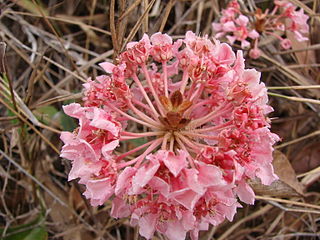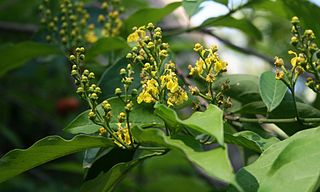
Adrien-Henri de Jussieu was a French botanist.

August Heinrich Rudolf Grisebach was a German botanist and phytogeographer. He was born in Hannover on 17 April 1814 and died in Göttingen on 9 May 1879.
Alicia is a genus in the Malpighiaceae, a family of about 75 genera of flowering plants in the order Malpighiales. Alicia comprises 2 species of woody vines widespread in South America.

Pterandra is a genus in the Malpighiaceae, a family of about 75 genera of flowering plants in the order Malpighiales. Pterandra comprises 15 species of trees, shrubs, and subshrubs, all but two native to South America, principally Colombia, Venezuela, and Brazil; the exceptions are from Panama.

Franz Josef Niedenzu was a German botanist born in Köppernig. He is remembered for his work with the botanical family Malpighiaceae.
Amorimia is a genus in the Malpighiaceae, a family of about 75 genera of flowering plants in the order Malpighiales. Amorimia comprises ten species of woody vines native to South America.
Thryallis is a genus in the family Malpighiaceae, of scandent shrubs and woody vines native to Brazil and adjacent Paraguay and Bolivia.

Bunchosia is a genus in the Malpighiaceae, a family of about 75 genera of flowering plants in the order Malpighiales. It contains roughly 75 species of trees and shrubs, which are native to dry woodlands, savannas, and wet forests. Their range extends from Mexico and the Caribbean to southeastern Brazil and adjacent Argentina. Bunchosia is one of three arborescent genera of Malpighiaceae with fleshy, bird-dispersed fruits.
Mascagnia is a genus in the Malpighiaceae, a family of about 75 genera of flowering plants in the order Malpighiales. Mascagnia comprises ca. 45 species that occur from northern Mexico to northern Argentina and southeastern Brazil and in the Caribbean in diverse habitats.

Stigmaphyllon is a genus in the Malpighiaceae, a family of about 75 genera of flowering plants in the order Malpighiales. Amazonvine is a common name for species in this genus.
José Cuatrecasas (1903–1996) was a botanist. He was born on March 19, 1903 in Camprodon, Catalonia, Spain.
Coleostachys is a genus in the Malpighiaceae, a family of about 75 genera of flowering plants in the order Malpighiales. Coleostachys contains only one species of shrubs or treelets found in wet forests of the Amazonian lowlands of French Guiana and adjacent Brazil.
Ectopopterys is a genus in the Malpighiaceae, a family of about 75 genera of flowering plants in the order Malpighiales. Ectopopterys contains only one species of woody vines native to lowland wet forests of Colombia, Ecuador, and Peru.
Glandonia is a genus in the Malpighiaceae, a family of about 75 genera of flowering plants in the order Malpighiales. Glandonia comprises 3 species of trees or shrubs native to lowland forests along rivers or in areas periodically flooded in Amazonian Colombia, Venezuela, and Brazil.
Mcvaughia is a genus in the Malpighiaceae, a family of about 75 genera of flowering plants in the order Malpighiales. Mcvaughia contains only one species, Mcvaughia bahiana, a shrub occurring in open shrubby vegetation (caatinga) on sandy soils of lowland Bahia, Brazil. It is related to Burdachia and Glandonia. The genus was named in honor of the American taxonomist Rogers McVaugh (1909–2009).
Echinopterys is a genus in the Malpighiaceae, a family of about 75 genera of flowering plants in the order Malpighiales. Echinopterys comprises 2 species of shrubs or woody vines native to dry habitats of Mexico and is distinctive in its bristly fruits.
Heladena is a genus in the Malpighiaceae, a family of about 75 genera of flowering plants in the order Malpighiales. Heladena includes one species, Heladena multiflora, a woody vine or sometimes a shrub or small tree native to gallery forests and woodlands of southern Brazil, Paraguay, and northeastern Argentina.
Psychopterys is a genus in the Malpighiaceae, a family of about 75 genera of flowering plants in the order Malpighiales. Psychopterys comprises 8 species of woody vines, occasionally described as shrubs or small trees, which occur in matorral, tropical deciduous forest, and wet forest in southern Mexico, Guatemala, and Belize. This genus is very distinctive because of its nearly radial white corollas and eglandular sepals, which are highly unusual characteristics in the Malpighiaceae of the New World.

Callaeum is a genus in the Malpighiaceae, a family of about 75 genera of flowering plants in the order Malpighiales. Callaeum comprises 11 species of woody vines and shrubs occurring from western Texas to Mexico, Central America, and South America. Two species, C. macropterum and C. septentrionale are cultivated as ornamentals in Arizona and California.








